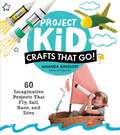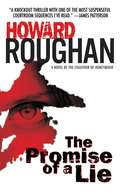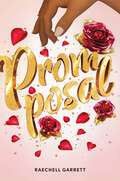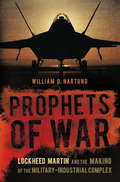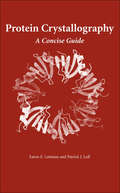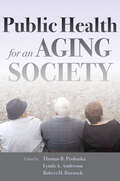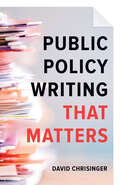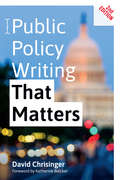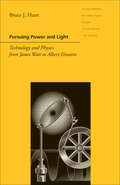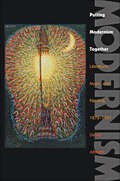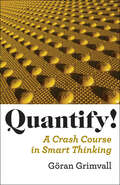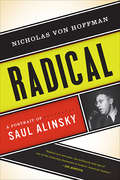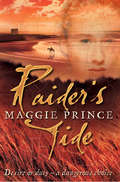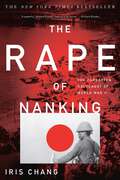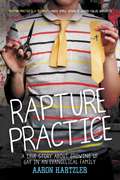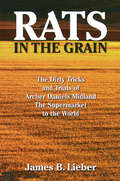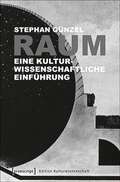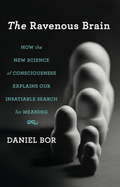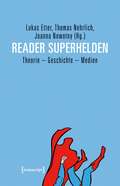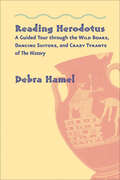- Table View
- List View
Project Kid: 60 Imaginative Projects That Fly, Sail, Race, and Dive
by Amanda KingloffThomas the Tank Engine. Hot Wheels. Mike Mulligan and His Steam Shovel. Richard Scarry&’s Cars and Trucks and Things That Go. Kids&’ fascination with vehicles is insatiable. In Project Kid: Crafts That Go!, that excitement is translated into more than 60 inventive craft projects for parents to make with and for their children. The book is organized into seven chapters: City, Rails, Sky, Space, Water, Country, and Dirt. There are police cars and ice cream trucks; circus trains and submarines; helicopters, rocket ships, cement mixers, and school buses. And because the car-obsessed kid doesn&’t just want a new vehicle to play with—he wants a racetrack, his very own driver&’s license, maybe even a child-sized gas station—each chapter includes not only toys but also thematic clothing, decor, accessories, and more. Projects feature clear instructions and step-by-step photographs wherever they are needed, easy for both kids and non-crafty adults to understand.
The Promise of a Lie
by Howard RoughanHoward Roughan?s debut, The Up and Comer, was hailed as one of the most hip and entertaining thrillers of the year. Now Roughan returns at full stride with a scintillating novel of deception that begins when a gifted young psychologist becomes entangled in the life of a beautiful and calculating patient. Nothing can prepare Dr. David Remler for the shocking phone call he receives from a patient named Samantha Kent. Stunned and anxious to help, he rushes out into the Manhattan night to keep a bloody act of violence from spinning further out of control. He knows he is too involved, that he?s crossed a line, and that his professional reputation is at stake. But he has no idea what awaits him at his destination...that he?s become a pawn in a very deadly game of revenge. Suddenly the focus of a criminal case that flares into an out-of-control media circus, David has only one shot to clear his name. But first he has to clear up the mystery of his patient, - Samantha Kent. Just who is she? And why did she choose to involve David? Little by little, the outlines of a brilliant plot emerge - and, with it, the horrifying power of a single lie - In this richly textured tale of a man?s battle against the mother of all manipulations, the perfect setup is even more diabolical than it looks.
Promposal
by RaeChell GarrettAn overachiever must decide if risking her heart by working with her former crush turned enemy is worth the reward in this snappy rom-com, perfect for fans of Tweet Cute and The Upside of Falling. High school senior Autumn Reeves has been waitlisted at her dream school. Determined to move to the top of the list, she must find a way to stand out. When a promposal she planned for a friend has half the senior class asking for her help, a brilliant business idea that will look great on her application is born: Promposal Queen. Autumn has no clue how to start a business, so she joins the Young Black Entrepreneurs group and finds herself face-to-face with Mekhi Winston, the boy whose unexpected freshman-year kiss—a kiss that meant everything to her and nothing to him—cost Autumn her best friend. He&’s the only person with the experience to help her, but how can she possibly trust him? With her dreams on the line, Autumn&’s willing to risk it. After all, Mekhi could be a good business partner without being a guy she would ever let near her heart again. But when working with Mekhi jeopardizes her only chance at rekindling a friendship with her ex-best-friend, and secrets long buried threaten to ruin Promposal Queen, another broken heart may be the least of her worries--her entire future is on the line.
Prophets of War: Lockheed Martin and the Making of the Military-Industrial Complex
by William D. HartungEnthralling and explosive, Prophets of War is an exposé of America's largest military contractor, Lockheed Martin. When President Dwight D. Eisenhower gave his famous warning about the dangers of the military industrial complex, he never would have dreamed that a company could accumulate the kind of power and influence now wielded by this behemoth company.As a full-service weapons maker, Lockheed Martin receives over 25 billion per year in Pentagon contracts. From aircraft and munitions, to the abysmal Star Wars missile defense program, to the spy satellites that the NSA has used to monitor Americans' phone calls without their knowledge, Lockheed Martin's reaches into all areas of US defense and American life. William Hartung's meticulously researched history follows the company's meteoric growth and explains how this arms industry giant has shaped US foreign policy for decades.
Prophets of War: Lockheed Martin and the Making of the Military-Industrial Complex
by William D HartungEnthralling and explosive, Prophets of War is an expos' of America's largest military contractor, Lockheed Martin. When President Dwight D. Eisenhower gave his famous warning about the dangers of the military industrial complex, he never would have dreamed that a company could accumulate the kind of power and influence now wielded by this behemoth company. As a full-service weapons maker, Lockheed Martin receives over 25 billion per year in Pentagon contracts. From aircraft and munitions, to the abysmal Star Wars missile defense program, to the spy satellites that the NSA has used to monitor Americans' phone calls without their knowledge, Lockheed Martin's reaches into all areas of US defense and American life. William Hartung's meticulously researched history follows the company's meteoric growth and explains how this arms industry giant has shaped US foreign policy for decades.
Protein Crystallography: A Concise Guide
by Eaton E. Lattman Patrick J. LollThe proteome remains a mysterious realm. Researchers have determined the structures of only a small fraction of the proteins encoded by the human genome. Crystallography continues to be the primary method used to determine the structures of the remaining unknown proteins. This imaging technique uses the diffraction of X-rays to determine a protein’s three-dimensional molecular structure.Drawing on years of research and teaching experience, Eaton E. Lattman and Patrick J. Loll use clear examples and abundant illustrations to provide a concise and accessible primer on protein crystallography. Discussing the basics of diffraction, the behavior of two- and three-dimensional crystals, phase determination (including MIR and MAD phasing and molecular replacement), the Patterson function, and refinement, Lattman and Loll provide a complete overview of this important technique, illuminated by physical insights.The crisp writing style and simple illustrations will provide beginner crystallographers with a guide to the process of unraveling protein structure.
Public Health for an Aging Society
by Lynda A. Anderson Robert H. Binstock Thomas R. ProhaskaPublic Health and Aging was published to critical acclaim almost fifteen years ago. Much has changed in public health since then. Thomas R. Prohaska, Lynda A. Anderson, and Robert H. Binstock now offer a completely new and updated overview of the field in Public Health for an Aging Society.This comprehensive survey discusses research, policy, and practice; managing and preventing diseases; promoting mental and physical health; and maintaining quality of life for an aging society. The fields of public health and aging have grown increasingly complex. Given the interdependency of issues posed by an aging society, the editors of this volume expand the traditional scope and treatments of public health and aging by adopting a social-ecological perspective that incorporates individual, family, community, societal, and environmental concerns. Chapters address the most critical public health issues facing an aging society, including Medicare and family caregiving, and introduce many new and emerging concepts, such as emergency preparedness, technology in aging, translational research, genomics, and environmental influences on health and health practices.The emergence of an aging society in the United States has far-reaching consequences for every generation. This book provides the latest information and future directions for the public health of this growing population. Students and practitioners will find Public Health for an Aging Society an invaluable resource both in the workplace and the classroom.
Public Policy Writing That Matters
by David ChrisingerStudents and professionals across a variety of disciplines need to write public policy in a manner that inspires action and genuine change. You may have amazing ideas about how to improve the world, but if you aren;€™t able to communicate these ideas well, they simply won;€™t become reality. In Public Policy Writing That Matters, communications specialist David Chrisinger argues that public policy writing is most persuasive when it tells clear, concrete stories about people doing things. Combining helpful hints and cautionary tales with writing exercises and excerpts from sample policy documents, Chrisinger teaches readers to craft concise, story-driven pieces that exceed the stylistic requirements and limitations of traditional policy writing.Too often, public policy writing is convoluted, opaque, and exclusive. Chrisinger, who teaches introductory policy writing courses around the country, offers a step-by-step guide for anyone interested in planning, organizing, developing, writing, and revising accessible public policy. From the most effective use of data visualization, the best way to write a sentence, and the ideal moment to add a compelling anecdote to advice on using facts to strengthen an argument, this little book, inspired by Strunk & White;€™s classic style guide, will allow anyone crafting public policy to make a bigger impact. Aimed at helping students and professionals overcome their default impulses to merely "explain," this book reveals proven, classroom-tested tips for writing sophisticated policy that is also easy to understand. This practical, concise handbook will not only aid students throughout graduate school but will also remain a reference to consult throughout their professional careers. A vital tool for any policy writer or analyst, Public Policy Writing That Matters is a book for everyone passionate about using writing to effect real and lasting change.
Public Policy Writing That Matters
by David ChrisingerStudents and professionals across a variety of disciplines need to write public policy in a manner that inspires action and genuine change. You may have amazing ideas about how to improve the world, but if you aren;€™t able to communicate these ideas well, they simply won;€™t become reality. In Public Policy Writing That Matters, communications specialist David Chrisinger argues that public policy writing is most persuasive when it tells clear, concrete stories about people doing things. Combining helpful hints and cautionary tales with writing exercises and excerpts from sample policy documents, Chrisinger teaches readers to craft concise, story-driven pieces that exceed the stylistic requirements and limitations of traditional policy writing.Too often, public policy writing is convoluted, opaque, and exclusive. Chrisinger, who teaches introductory policy writing courses around the country, offers a step-by-step guide for anyone interested in planning, organizing, developing, writing, and revising accessible public policy. From the most effective use of data visualization, the best way to write a sentence, and the ideal moment to add a compelling anecdote to advice on using facts to strengthen an argument, this little book, inspired by Strunk & White;€™s classic style guide, will allow anyone crafting public policy to make a bigger impact. Aimed at helping students and professionals overcome their default impulses to merely "explain," this book reveals proven, classroom-tested tips for writing sophisticated policy that is also easy to understand. This practical, concise handbook will not only aid students throughout graduate school but will also remain a reference to consult throughout their professional careers. A vital tool for any policy writer or analyst, Public Policy Writing That Matters is a book for everyone passionate about using writing to effect real and lasting change.
Public Policy Writing That Matters
by David ChrisingerA thoroughly updated and expanded guide to honing your public policy writing skills—and making a significant impact on the world.Professionals across a variety of disciplines need to write about public policy in a manner that inspires action and genuine change. You may have amazing ideas about how to improve the world, but if you aren't able to communicate these ideas well, they simply won't become a reality. In Public Policy Writing That Matters, communications expert David Chrisinger, who directs the Harris Writing Program at the University of Chicago and worked in the US Government Accountability Office for a decade, argues that public policy writing is most persuasive when it tells clear, concrete stories about people doing things. Combining helpful hints and cautionary tales with writing exercises and excerpts from sample policy analysis, Chrisinger teaches readers to craft concise, story-driven pieces that exceed the stylistic requirements and limitations of traditional policy writing.Aimed at helping students and professionals overcome their default impulses to merely "explain," this book reveals proven tips—tested in the real world and in the classroom—for writing sophisticated policy analysis that is also easy to understand. For anyone interested in planning, organizing, developing, writing, and revising accessible public policy, Chrisinger offers a step-by-step guide that covers everything from the most effective use of data visualization to the best ways to write a sentence, from the ideal moment for adding a compelling anecdote to advice on using facts to strengthen an argument. This second edition addresses the current political climate and touches on policy changes that have occurred since the book was originally published. A vital tool for any policy writer or analyst, Public Policy Writing That Matters is a book for everyone passionate about using writing to effect real and lasting change.
Public Policy Writing That Matters
by David ChrisingerA thoroughly updated and expanded guide to honing your public policy writing skills—and making a significant impact on the world.Professionals across a variety of disciplines need to write about public policy in a manner that inspires action and genuine change. You may have amazing ideas about how to improve the world, but if you aren't able to communicate these ideas well, they simply won't become a reality. In Public Policy Writing That Matters, communications expert David Chrisinger, who directs the Harris Writing Program at the University of Chicago and worked in the US Government Accountability Office for a decade, argues that public policy writing is most persuasive when it tells clear, concrete stories about people doing things. Combining helpful hints and cautionary tales with writing exercises and excerpts from sample policy analysis, Chrisinger teaches readers to craft concise, story-driven pieces that exceed the stylistic requirements and limitations of traditional policy writing.Aimed at helping students and professionals overcome their default impulses to merely "explain," this book reveals proven tips—tested in the real world and in the classroom—for writing sophisticated policy analysis that is also easy to understand. For anyone interested in planning, organizing, developing, writing, and revising accessible public policy, Chrisinger offers a step-by-step guide that covers everything from the most effective use of data visualization to the best ways to write a sentence, from the ideal moment for adding a compelling anecdote to advice on using facts to strengthen an argument. This second edition addresses the current political climate and touches on policy changes that have occurred since the book was originally published. A vital tool for any policy writer or analyst, Public Policy Writing That Matters is a book for everyone passionate about using writing to effect real and lasting change.
Pursuing Power and Light: Technology and Physics from James Watt to Albert Einstein (Johns Hopkins Introductory Studies in the History of Science)
by Bruce J. HuntIn the nineteenth century, science and technology developed a close and continuing relationship. The most important advancements in physics—the science of energy and the theory of the electromagnetic field—were deeply rooted in the new technologies of the steam engine, the telegraph, and electric power and light. Bruce J. Hunt here explores how the leading technologies of the industrial age helped reshape modern physics.This period marked a watershed in how human beings exerted power over the world around them. Sweeping changes in manufacturing, transportation, and communications transformed the economy, society, and daily life in ways never before imagined. At the same time, physical scientists made great strides in the study of energy, atoms, and electromagnetism. Hunt shows how technology informed science and vice versa, examining the interaction between steam technology and the formulation of the laws of thermodynamics, for example, and that between telegraphy and the rise of electrical science.Hunt’s groundbreaking introduction to the history of physics points to the shift to atomic and quantum physics. It closes with a brief look at Albert Einstein’s work at the Swiss patent office and the part it played in his formulation of relativity theory. Hunt translates his often-demanding material into engaging and accessible language suitable for undergraduate students of the history of science and technology.
Putting Modernism Together: Literature, Music, and Painting, 1872–1927 (Hopkins Studies in Modernism)
by Daniel AlbrightHow do you rationally connect the diverse literature, music, and painting of an age? Throughout the modernist era�which began roughly in 1872 with the Franco-Prussian War, climaxed with the Great War, and ended with a third catastrophe, the Great Depression�there was a special belligerence to this question. It was a cultural period that envisioned many different models of itself: to the Cubists, it looked like a vast jigsaw puzzle; to the Expressionists, it resembled a convulsive body; to the Dadaists, it brought to mind a heap of junk following an explosion. In Putting Modernism Together, Daniel Albright searches for the center of the modernist movement by assessing these various artistic models, exploring how they generated a stunning range of creative work that was nonetheless wound together aesthetically, and sorting out the cultural assumptions that made each philosophical system attractive. Emerging from Albright's lectures for a popular Harvard University course of the same name, the book investigates different methodologies for comparing the evolution and congruence of artistic movements by studying simultaneous developments that occurred during particularly key modernist years. What does it mean, Albright asks, that Joseph Conrad's Heart of Darkness, published in 1899, appeared at the same time as Claude Debussy's Nocturnes�beyond the fact that the word "Impressionist" has been used to describe each work? Why, in 1912, did the composer Arnold Schoenberg and the painter Vassily Kandinsky feel such striking artistic kinship? And how can we make sense of a movement, fragmented by isms, that looked for value in all sorts of under- or ill-valued places, including evil (Baudelaire), dung heaps (Chekhov), noise (Russolo), obscenity (Lawrence), and triviality (Satie)? Throughout Putting Modernism Together, Albright argues that human culture can best be understood as a growth-pattern or ramifying of artistic, intellectual, and political action. Going beyond merely explaining how the artists in these genres achieved their peculiar effects, he presents challenging new analyses of telling craft details which help students and scholars come to know more fully this bold age of aesthetic extremism.
Quantify!: A Crash Course in Smart Thinking
by Göran GrimvallGöran Grimvall is determined to help mere mortals understand how scientists get to the kernel of perplexing problems. Entertaining and enlightening, his latest book uses examples from sports, literature, and nature—as well as from the varied worlds of science—to illustrate how scientists make sense of and explain the world around us. Grimvall's fun-to-read essays and easy-to-follow examples detail how order-of-magnitude estimation, extreme cases, dimensional analysis, and other modeling methods work. They also reveal how nonscientists absorb these concepts and use them at home, school, and work. Grimvall's simple, elegant explanations will help you tap into your inner scientist. Read this book and enjoy your own "Aha!" moment.
Radical: A Portrait of Saul Alinsky
by Nicholas von HoffmanFrom Left to Right, one man has influenced them all: Saul Alinsky. Radical is a personal portrait of this controversial mastermind of popular movements, a man who is often called the American Machiavelli. The tactics and strategy of Alinsky, who died in 1972, have been studied by people as diverse as Barack Obama, Cesar Chavez, Hillary Clinton, Dick Armey, the Tea Partiers, and activists and organizers of every persuasion. Thousands of organizations around the country owe their inspiration and origins to Alinsky—who is to community organizing what Freud is to psychoanalysis. As told by his friend and protégé Nicholas von Hoffman, whom Alinsky dubbed &“in all the world my favorite, drinking, talking, and thinking companion,&” Radical is an intimate look at the man who made a career of arming the powerless and enraging the powerful. From Alinsky&’s smuggling guinea pigs into the Joliet state penitentiary to the famous Buffalo fart-in. von Hoffman&’s book reveals the humor as well as the ideals and anger that drove Alinsky to become a major figure in a democratic tradition dating back to Tom Paine. Many of the stories about politicians, bishops, gangsters, millionaires, and labor leaders, which Alinsky did not want made public in his lifetime, are told here for the first time in Radical. Von Hoffman captures Alinsky&’s brilliant critique of Dr. Martin Luther King, Jr.&’s organizational tactics and where and why they succeeded or failed. It was a career that began in the politics and violence of the Great Depression and worked its way through the Communist threat, the racial struggles, and the Vietnam War protests of the second half of the twentieth century. The first book to explain why so many have co-opted Alinsky&’s ideas, and the first to explain why so many contemporary politicians misunderstand his message, Radical will become essential reading for anyone interested in American politics, past and present.
Radical: A Portrait of Saul Alinsky
by Nicholas von HoffmanFrom Left to Right, one man has influenced them all: Saul Alinsky. Radical is a personal portrait of this controversial mastermind of popular movements, a man who is often called the American Machiavelli. The tactics and strategy of Alinsky, who died in 1972, have been studied by people as diverse as Barack Obama, Cesar Chavez, Hillary Clinton, Dick Armey, the Tea Partiers, and activists and organizers of every persuasion. Thousands of organizations around the country owe their inspiration and origins to Alinsky -- who is to community organizing what Freud is to psychoanalysis. As told by his friend and proté Nicholas von Hoffman, whom Alinsky dubbed "in all the world my favorite, drinking, talking, and thinking companion," Radical is an intimate look at the man who made a career of arming the powerless and enraging the powerful. From Alinsky's smuggling guinea pigs into the Joliet state penitentiary to the famous Buffalo fart-in. von Hoffman's book reveals the humor as well as the ideals and anger that drove Alinsky to become a major figure in a democratic tradition dating back to Tom Paine. Many of the stories about politicians, bishops, gangsters, millionaires, and labor leaders, which Alinsky did not want made public in his lifetime, are told here for the first time in Radical. Von Hoffman captures Alinsky's brilliant critique of Dr. Martin Luther King, Jr.'s organizational tactics and where and why they succeeded or failed. It was a career that began in the politics and violence of the Great Depression and worked its way through the Communist threat, the racial struggles, and the Vietnam War protests of the second half of the twentieth century. The first book to explain why so many have co-opted Alinsky's ideas, and the first to explain why so many contemporary politicians misunderstand his message, Radical will become essential reading for anyone interested in American politics, past and present.
Raider’s Tide
by Maggie PrinceStrong historical fiction and powerful romantic drama set in border country during Elizabethan times – forbidden passions and family loyalties; heresy and witchcraft, but at the heart of it, the burgeoning love of a young girl.
The Rape Of Nanking: The Forgotten Holocaust Of World War II
by Iris ChangThe New York Times bestselling account of one of history's most brutal -- and forgotten -- massacres, when the Japanese army destroyed China's capital city on the eve of World War II In December 1937, one of the most horrific atrocities in the long annals of wartime barbarity occurred. The Japanese army swept into the ancient city of Nanking (what was then the capital of China), and within weeks, more than 300,000 Chinese civilians and soldiers were systematically raped, tortured, and murdered. In this seminal work, Iris Chang, whose own grandparents barely escaped the massacre, tells this history from three perspectives: that of the Japanese soldiers, that of the Chinese, and that of a group of Westerners who refused to abandon the city and created a safety zone, which saved almost 300,000 Chinese. Drawing on extensive interviews with survivors and documents brought to light for the first time, Iris Chang's classic book is the definitive history of this horrifying episode. "Chang vividly, methodically, records what happened, piecing together the abundant eyewitness reports into an undeniable tapestry of horror." - Adam Hochschild, Salon
Rapture Practice: A True Story About Growing Up Gay in an Evangelical Family
by Aaron HartzlerA poignant and funny memoir that explores growing up in a Fundamentalist Christian family while questioning one's faith, identity, and place in the world.Sometimes salvation is found in the strangest places: a true story.Aaron Hartzler grew up in a home where he was taught that at any moment the Rapture could happen. That Jesus might come down in the twinkling of an eye and scoop Aaron and his family up to heaven. As a kid, Aaron was thrilled by the idea that every moment of every day might be his last one on planet Earth.But as Aaron turns sixteen, he finds himself more attached to his earthly life and curious about all the things his family forsakes for the Lord. He begins to realize he doesn't want the Rapture to happen just yet--not before he sees his first movie, stars in the school play, or has his first kiss. Eventually Aaron makes the plunge from conflicted do-gooder to full-fledged teen rebel.Whether he's sneaking out, making out, or playing hymns with a hangover, Aaron learns a few lessons that can't be found in the Bible. He discovers that the best friends aren't always the ones your mom and dad approve of, and the tricky part about believing is that no one can do it for you.In this funny and heartfelt coming-of-age memoir, debut author Aaron Hartzler recalls his teenage journey to find the person he is without losing the family that loves him. It's a story about losing your faith and finding your place and your own truth--which is always stranger than fiction.
Rats in the Grain: The Dirty Tricks and Trials of Archer Daniels Midland, the Supermarket to the World
by James B. LieberBeneath the wholesome image of Archer Daniels Midland lie some of the dirtiest practices in American business: price-fixing, bribery, and cover-ups. Unfolding like a legal thriller, Rats in the Grain portrays the crime and punishment of ADM during the largest white-collar criminal trial of the 1990s. James Lieber profiles the witnesses, the defense lawyers and federal prosecutors, the inner workings of the Justice Department's Antitrust Division, and the unpredictable mole Lieber had access to. "A detailed account of how an influential corporation can go rotten." - The Cleveland Plain Dealer
The Ravenous Brain: How the New Science of Consciousness Explains Our Insatiable Search for Meaning
by Daniel BorConsciousness is our gateway to experience: it enables us to recognize Van Gogh&’s starry skies, be enraptured by Beethoven&’s Fifth, and stand in awe of a snowcapped mountain. Yet consciousness is subjective, personal, and famously difficult to examine: philosophers have for centuries declared this mental entity so mysterious as to be impenetrable to science. In The Ravenous Brain, neuroscientist Daniel Bor departs sharply from this historical view, and builds on the latest research to propose a new model for how consciousness works. Bor argues that this brain-based faculty evolved as an accelerated knowledge gathering tool. Consciousness is effectively an idea factory—that choice mental space dedicated to innovation, a key component of which is the discovery of deep structures within the contents of our awareness. This model explains our brains&’ ravenous appetite for information—and in particular, its constant search for patterns. Why, for instance, after all our physical needs have been met, do we recreationally solve crossword or Sudoku puzzles? Such behavior may appear biologically wasteful, but, according to Bor, this search for structure can yield immense evolutionary benefits—it led our ancestors to discover fire and farming, pushed modern society to forge ahead in science and technology, and guides each one of us to understand and control the world around us. But the sheer innovative power of human consciousness carries with it the heavy cost of mental fragility. Bor discusses the medical implications of his theory of consciousness, and what it means for the origins and treatment of psychiatric ailments, including attention-deficit disorder, schizophrenia, manic depression, and autism. All mental illnesses, he argues, can be reformulated as disorders of consciousness—a perspective that opens up new avenues of treatment for alleviating mental suffering. A controversial view of consciousness, The Ravenous Brain links cognition to creativity in an ingenious solution to one of science&’s biggest mysteries.
Reader Superhelden: Theorie - Geschichte - Medien (Edition Kulturwissenschaft #133)
by Lukas Etter Thomas Nehrlich Joanna NowotnySind Superheldinnen feministisch? Welche Rolle spielten antike Mythen, die biblische Geschichte des Simson oder Nietzsches Philosophie für die Schöpfer von Superman? Und was hat die Nibelungensage mit Marvel zu tun? Antworten auf diese und weitere Fragen - u.a. nach der vielfältigen Medialität und Rezeptionsgeschichte von Superhelden-Stories, der Perspektive der Comicschaffenden auf ihre Kunst und dem sich wandelnden Bild des Superhelden in der aktuellen Forschung - gibt dieser Reader, der erstmals in deutscher Sprache und für ein breites Publikum Texte zu Theorie und Geschichte der Superhelden versammelt und kommentiert. Mit Texten u.a. von Shilpa Davé, Umberto Eco, Stan Lee, Friedrich Nietzsche und Véronique Sina und Interviews u.a. mit Frank Miller, Alan Moore und Roy Lichtenstein.
Reading Herodotus: A Guided Tour through the Wild Boars, Dancing Suitors, and Crazy Tyrants of The History
by Debra HamelDebra Hamel’s book is a lively introduction to The History of the Persian Wars, Herodotus's account of Persia's expansion under four kings—Cyrus, Cambyses, Darius, and Xerxes—and its eventual collision with the city-states of Greece. The History can be a long slog for modern readers, but it is full of salacious tales about sex, violent death, divine prophecies, and cannibals. Following the structure of the original work, Hamel leads the reader through a colorful tour of the central stories that compose The History. She highlights the more interesting and important parts of the story while providing readers who are new to Herodotus with the background information necessary to appreciate the author’s wide-ranging subject matter. At once academic and cheeky, the experience of this book is like reading Herodotus while simultaneously consulting a history of Greece and a scholarly commentary on the text.
Reading Herodotus: A Guided Tour through the Wild Boars, Dancing Suitors, and Crazy Tyrants of <I>The History</I>
by Debra HamelDebra Hamel’s book is a lively introduction to The History of the Persian Wars, Herodotus's account of Persia's expansion under four kings—Cyrus, Cambyses, Darius, and Xerxes—and its eventual collision with the city-states of Greece. The History can be a long slog for modern readers, but it is full of salacious tales about sex, violent death, divine prophecies, and cannibals. Following the structure of the original work, Hamel leads the reader through a colorful tour of the central stories that compose The History. She highlights the more interesting and important parts of the story while providing readers who are new to Herodotus with the background information necessary to appreciate the author’s wide-ranging subject matter. At once academic and cheeky, the experience of this book is like reading Herodotus while simultaneously consulting a history of Greece and a scholarly commentary on the text.
